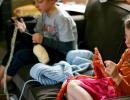Learning to crochet: crossed and crossed stitches. Embossed crochet stitches crochet crochet pattern crossed stitches
Crossed double crochets there are different ones. Previously, we considered a method where the columns overlap each other. Today we will knit one from the other. You can learn what it means to knit stitches in an overlap from the lesson. They are denser, warmer and can be used even in winter products. And the columns we are considering today are completely unsuitable for winter, but are perfect for sunny summer things! 🙂
Crossed double crochets as an element of a pattern or an independent pattern
After watching the master class, you will have a complete guide to action. This element can be used either independently, that is, a pattern completely made using it, or in combination with others. For example, you can knit a fabric using a fillet mesh and add rows of crossed stitches to it. This will add zest to the pattern, take away the boringness and fill the work with variety. The crossed double crochet pattern looks like the letter X and consists of four single crochets knitted in succession. Be sure to review and try this element, it may inspire you to others interesting ideas, which can become copyrighted! 🙂 I suggest moving on to looking at the element.
1. We dial an arbitrary even number (divisible by 2). I'm 16
2. Three airy ones are the edge of our pattern

3. We make two yarn overs on the hook, count the fifth loop from the hook, thread the hook

4. We pick up the working thread and pull it through the chain. 4 loops on hook

5. We grab the working thread and pull it through the first two loops. We knitted the first yarn over of the lower right stitch

6. Yarn over for the lower right column


8. We grab the working thread and pull it through the chain. There are 5 loops on the hook

9. We grab the working thread and pull it through the leftmost two loops. This is knitted over the lower left stitch

10. We grab the working thread and pull it through the outer two loops again. We have completed knitting the two lower stitches. They have a common top

11. We grab the working thread and pull it through the outermost at the moment two loops. Yarn over the top right column. There are two loops left on the hook


13. We make a yarn over for further knitting of the upper left column





18. Let's move on to the next element of crossed columns. We make two yarn overs



21. Grab the working thread and pull it through the last two loops on the hook. We started and didn’t finish the bottom right column

22. Yarn over for the bottom left column



25. Grab the working thread and pull it through the outer two loops. This is the second unknitted column








33. Grab the working thread again and pull it through the remaining two loops on the hook. We have completed the top left column. Crossed column element completed





We will learn to knit crossed stitches with two crochets, and not simple stitches, but embossed ones.
We collect a chain of air loops the length we need.
We knit the 1st row simply with double crochets.
2nd row: 4VP, skip two base loops, then knit two embossed double crochets. To do this, we make two yarn overs, insert the hook under the body of the column of the previous row, pull out the working loop longer and knit the loops together one by one. We knit the second embossed column in the same way.


Thus we continue to knit the entire row.
I repeat once again: first we knit embossed columns under the 3rd and 4th columns of the previous row, then under the 1st and 2nd.
At the end of the row we knit one C2H into the last stitch of the base.
This is how you get crossed columns.
Turn the knitting.
We also knit all odd (purl) rows.
4th row: knit similarly to the 2nd, but the columns should be crossed at the bottom.
At the beginning of the row 4VP, 2 regular single crochets, skip 2 base loops, 2 embossed C2H.


We knit the second crossed relief column.
We get columns crossed at the top in one row, and crossed at the bottom in the other.
I took a photo, but perhaps it will be more obvious and understandable if you watch the video from which I learned to crochet crossed double crochets.
The crossed column, as its name suggests, looks like a cross. Most often, crossed stitches are knitted with one crochet. So, let's see step by step in the photographs how to knit a crossed stitch with one crochet.
For crossed single crochet stitches at the beginning of the row, four chain loops are needed for lifting. We make two yarn overs, insert the hook into the fifth loop from the hook, pick up the working thread, and pull out the loop. There are 4 loops on the hook. 
We pick up the working thread again and pull it through two loops. There are 3 loops left on the hook.

Yarn over, skip one loop on the initial chain of chain stitches and insert the hook into the next loop. We pick up the working thread and pull out the loop. There are 5 loops on the hook.

We pick up the working thread, pull it through two loops, leaving 4 loops on the hook.

Once again we pick up the working thread and knit two loops. Now there are 3 loops on the hook, and the “legs” of the column have converged at one point.

We pick up the working thread again and pull it through two loops. There are 2 loops on the hook.

Once again we knit two loops, leaving 1 loop on the hook. We knitted the right "handle" of the column.

Now we knit 1 air loop. In our example, there is 1 loop between the “legs” and “handles” of the column. If you want the “legs” and “handles” to be spaced wider, you can make 2 loops. Next, we make a yarn over and insert the hook into the junction of the “legs” of the crossed column.

We pick up the working thread and pull out the loop. There should be 4 loops on the hook. We knit two loops in succession, 1 loop on the hook. We knitted the left “handle” of the crossed column.

This is what crossed single crochet stitches look like.
An example of a pattern knitted with crossed columns: pattern diagram.
Learning to crochet: crossed and crossed stitches.Crossed double crochet:
Knit 2 double crochets crosswise: first on the 2nd loop of the base, then on the 1st.
Crossed double crochet:
(5 lifting loops correspond to it). Having made 2 yarn overs, insert the hook into the 6th loop of the chain, pick up the working thread and pull it through this loop (4 loops on the hook). Pick up the working thread
and knit 2 loops (there are 3 loops on the hook). Without knitting loops on the hook, make a yarn over, insert the hook into the base loop through one loop to the left of the 1st stitch, pick up the working thread and pull it through this loop (5 loops on the hook). Next, picking up the working thread,
alternately knit 2 loops 4 times (1 loop remains on the hook). Make 1 air loop, yarn over and insert the hook into the center of the column, grabbing 2 threads,
pick up the working thread and pull it through 2 threads of the center of the column (3 loops on the hook). Picking up the working thread, knit 2 loops 2 times.
These columns can form an independent pattern and be combined with other columns.
I once came across a photo of an incredibly beautiful blanket on the internet, but at first I couldn’t understand how it was connected. But then I realized that the pattern used crossed columns.
We will learn to knit crossed stitches with two crochets, and not simple stitches, but embossed ones.
We assemble a chain of air loops of the length we need.
We knit the 1st row simply with double crochets.
2nd row: 4VP, skip two base loops, then knit two embossed double crochets. To do this, we make two yarn overs, insert the hook under the body of the column of the previous row, pull out the working loop longer and knit the loops together one by one. We knit the second embossed column in the same way.
Thus we continue to knit the entire row.
I repeat once again: first we knit embossed columns under the 3rd and 4th columns of the previous row, then under the 1st and 2nd.
At the end of the row we knit one C2H into the last stitch of the base.
This is how you get crossed columns.
Turn the knitting.
We also knit all odd (purl) rows.
4th row: knit similarly to the 2nd, but the columns should be crossed at the bottom.
At the beginning of the row 4VP, 2 regular single crochets, skip 2 base loops, 2 embossed C2H.
We knit the second crossed relief column.
We get columns crossed at the top in one row, and crossed at the bottom in the other.
I took a photo, but perhaps it will be more obvious and understandable if you watch the video from which I learned to crochet crossed double crochets.
I must say that, out of habit, I didn’t succeed right away, but then I got the hang of it.










